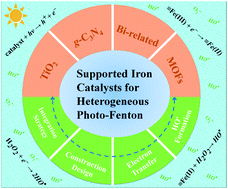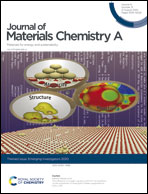Nanostructured semiconductor supported iron catalysts for heterogeneous photo-Fenton oxidation: a review
Abstract
Heterogeneous Fenton oxidation based on interfacial reactions between solid iron catalysts (![[triple bond, length as m-dash]](https://www.rsc.org/images/entities/char_e002.gif) Fe) and H2O2 to produce hydroxyl radicals for organic wastewater treatment has attracted wide interest. Compared with homogeneous Fenton oxidation, it overcomes the pH limitation and sludge production problem, but also encounters several challenging issues, such as low-density
Fe) and H2O2 to produce hydroxyl radicals for organic wastewater treatment has attracted wide interest. Compared with homogeneous Fenton oxidation, it overcomes the pH limitation and sludge production problem, but also encounters several challenging issues, such as low-density ![[triple bond, length as m-dash]](https://www.rsc.org/images/entities/char_e002.gif) Fe(II) sites and/or sluggish
Fe(II) sites and/or sluggish ![[triple bond, length as m-dash]](https://www.rsc.org/images/entities/char_e002.gif) Fe(II) regeneration for H2O2 activation, high H2O2 consumption, and insufficient catalyst stability. Numerous studies have been devoted to optimizing catalyst's composition and structure and/or applying external physical energies to enhance electron transfer and accelerate the redox cycle of
Fe(II) regeneration for H2O2 activation, high H2O2 consumption, and insufficient catalyst stability. Numerous studies have been devoted to optimizing catalyst's composition and structure and/or applying external physical energies to enhance electron transfer and accelerate the redox cycle of ![[triple bond, length as m-dash]](https://www.rsc.org/images/entities/char_e002.gif) Fe(III)/Fe(II) to boost H2O2 activation. Among various strategies, the combination of photocatalysis and heterogeneous Fenton oxidation (heterogeneous catalytic photo-Fenton oxidation) is promising and has attracted wide attention with tremendous research progress being made. Based on a comprehensive literature survey, this review summarizes and analyses state-of-the-art research in this field. Firstly, a general background, especially the principles of heterogeneous photo-Fenton oxidation, is provided. Then, the recent developments in constructing supported iron catalysts for heterogeneous photo-Fenton oxidation are summarized, with a focus on iron catalysts supported on four popular semiconductors (TiO2, carbon nitride, bismuth-related crystals and metal–organic frameworks). The synthesis strategies of iron catalysts supported on these semiconductors are analysed with a focus on iron species in different states, from lattice doping and single-atom sites, to surface amorphous/crystalline nanoparticles, and further to heterojunctions. The synergetic behaviours between the semiconductor supports and iron species and their electron migration pathways and active species formation mechanisms in heterogeneous photo-Fenton oxidation are summarized. Afterwards, several critical influencing factors on performance, including catalyst factors (light absorption, electron transfer, iron loading amount, and defects) and processing parameters (radicals, solution pH and catalyst separation), are discussed. Finally, typical semiconductor supported transition metal catalysts for sulfate radical production and other iron catalysts supported on conventional supports (silicas, zeolites, carbons and clays) for heterogeneous photo-Fenton oxidation are briefly described. In this review, some suggestions for future research in this field are also provided. We hope this review could provide a basic understanding of heterogeneous photo-Fenton oxidation and attract more interest to further develop this technology toward practical water treatment.
Fe(III)/Fe(II) to boost H2O2 activation. Among various strategies, the combination of photocatalysis and heterogeneous Fenton oxidation (heterogeneous catalytic photo-Fenton oxidation) is promising and has attracted wide attention with tremendous research progress being made. Based on a comprehensive literature survey, this review summarizes and analyses state-of-the-art research in this field. Firstly, a general background, especially the principles of heterogeneous photo-Fenton oxidation, is provided. Then, the recent developments in constructing supported iron catalysts for heterogeneous photo-Fenton oxidation are summarized, with a focus on iron catalysts supported on four popular semiconductors (TiO2, carbon nitride, bismuth-related crystals and metal–organic frameworks). The synthesis strategies of iron catalysts supported on these semiconductors are analysed with a focus on iron species in different states, from lattice doping and single-atom sites, to surface amorphous/crystalline nanoparticles, and further to heterojunctions. The synergetic behaviours between the semiconductor supports and iron species and their electron migration pathways and active species formation mechanisms in heterogeneous photo-Fenton oxidation are summarized. Afterwards, several critical influencing factors on performance, including catalyst factors (light absorption, electron transfer, iron loading amount, and defects) and processing parameters (radicals, solution pH and catalyst separation), are discussed. Finally, typical semiconductor supported transition metal catalysts for sulfate radical production and other iron catalysts supported on conventional supports (silicas, zeolites, carbons and clays) for heterogeneous photo-Fenton oxidation are briefly described. In this review, some suggestions for future research in this field are also provided. We hope this review could provide a basic understanding of heterogeneous photo-Fenton oxidation and attract more interest to further develop this technology toward practical water treatment.

- This article is part of the themed collection: Journal of Materials Chemistry A Emerging Investigators


 Please wait while we load your content...
Please wait while we load your content...